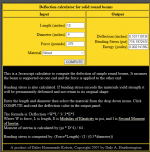ENGLISH et al,
After more than 14,000 hits and over 500 posts, who benefitted from this thread?
Those that have followed it from the beginning or those that jumped on it with a desire to get a consensus or resolution and quit?
I hope that Dr. Dave believes that all here have benefitted from Jal's challenging contributions and Cornerman's practical observations. I also know that Dr. Dave has more AZ students who have increased their knowledge over and above just feel.
In my engineering work, we are encouraged to think outside of the box which puts trust in intuition and not just paradigms. We all observe and have intuitions even though we may not have the pedigree of those that many seek for easy answers. Science and empirical studies start with an intuition that begs for proof that most don't have the capacity to provide.
This AZ forum provides a peer review for those intuitions that anyone can proffer by posting. One may get "stoned" for their thoughts as you know, but one has to be honest with what they observe and believe and even seek proof or quit.
This thread is an extension of an age old question to debunk the paradigm that the transverse force is an insignificant contributor to the effective end mass of the shaft that effects squirt.
What causes squirt is a complex combination of force vectors and resonance imparted to the CB for which no complete equation or algorithm has been presented to be embraced or debunked - who has the interest and resources?
With that said, one day we may have a perfect cue with the perfect end mass and flexibility to eliminate squirt - if that floats your boat.:smile:
Be well
something like that isn't really that far off i wouldn't think. I figure with nano tech and the piezoelectric fabrics....i wouldn't deem it far fetched that Lucasi will be selling programmable shafts in the future.
Now something like that could possibly "perform" better than wood, like those sniper rifles with the aim correct and bullets that adjust lol....but i dont think fit, feel, finish, touch...all the qualities we look for, are never going to be one upped by us making some new product...it would have to be HGPI rock maple grown into a shaft blank in less than 30 days.


